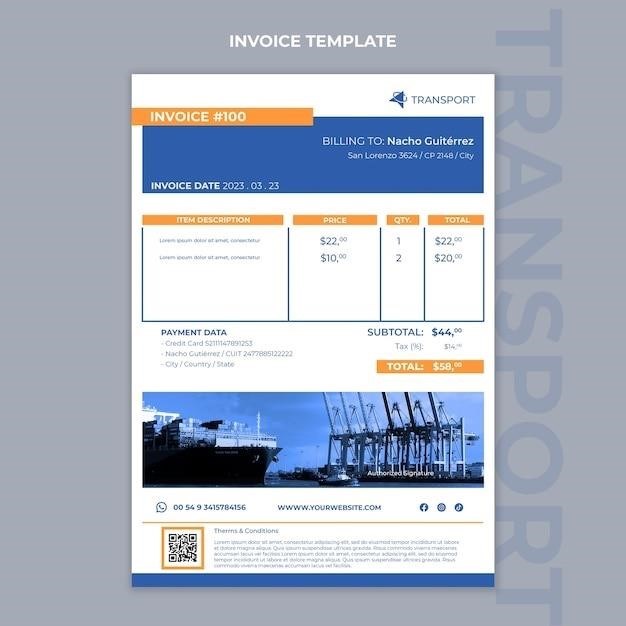This comprehensive guide will help you understand the tanker endorsement, a crucial requirement for drivers who transport liquid or gaseous materials in tanker vehicles․ You’ll learn about the different types of tankers and cargo, the CDL requirements for the tanker endorsement, and how to prepare for the tanker endorsement exam․ We’ll also cover safety protocols, tanker-specific regulations, and practice tests to help you ace the exam and obtain your endorsement․
The Tanker Endorsement, often referred to as the “N” endorsement, is a crucial addition to your Commercial Driver’s License (CDL) if you aspire to operate tanker vehicles․ This endorsement signifies that you have successfully completed the necessary training and passed the required exams, demonstrating your proficiency in safely handling and transporting liquid or gaseous materials․ Obtaining this endorsement is a vital step towards a career in the specialized field of tanker driving, opening doors to various opportunities within the transportation industry․
The Tanker Endorsement is not a standalone license; it is an addition to your existing CDL, typically Class A or Class B, depending on the type of tanker you intend to operate․ It signifies that you have met the specific requirements for safely handling and transporting hazardous materials, such as liquids or gases․ This includes understanding the unique challenges associated with tanker operations, such as liquid surge, cargo stability, and the intricacies of handling different types of cargo․
The Tanker Endorsement is not just a piece of paper; it’s a testament to your commitment to safety and your ability to operate a tanker vehicle responsibly․ It signifies your expertise in navigating the complexities of tanker transportation, ensuring the safe delivery of valuable cargo while adhering to stringent safety protocols․
The world of tanker transportation is diverse, encompassing a wide array of tanker types designed to carry various liquid and gaseous cargo․ Understanding these different tanker types and their associated cargo is crucial for tanker drivers․
One common classification is based on the type of cargo⁚
- Liquid Cargo Tankers⁚ These tankers are designed to transport various liquids, including petroleum products (gasoline, diesel, kerosene), chemicals, food products (milk, juice), and even water․
- Gaseous Cargo Tankers⁚ These tankers specialize in transporting gases like propane, butane, and natural gas․ They are equipped with specialized compartments and pressure-regulating systems to safely handle these volatile substances․
Tankers are also classified by their design and construction⁚
- Cargo Tanks⁚ These are permanently mounted tanks on a truck chassis, often used for transporting liquids․
- Portable Tanks⁚ These tanks are designed to be detachable and can be transported on trailers or flatbeds․ They offer flexibility for various applications․
- Cryogenic Tankers⁚ Specialized for transporting extremely cold liquids like liquid nitrogen or oxygen, these tankers feature advanced insulation and pressure-regulating systems․
As a tanker driver, you need to be familiar with the types of tankers and their cargo to ensure safe handling and transportation, adhering to specific regulations and safety protocols for each type of cargo․
Obtaining a tanker endorsement on your Commercial Driver’s License (CDL) requires meeting specific requirements․ These requirements vary slightly from state to state but generally include⁚
- Valid CDL⁚ You must hold a valid CDL with either a Class A or Class B license․ Class A is for combination vehicles exceeding 26,001 pounds, with the towed vehicle weighing over 10,000 pounds․ Class B is for single vehicles exceeding 26,001 pounds or a combination of vehicles where the towed vehicle weighs 10,000 pounds or less․
- Age Requirement⁚ The minimum age for obtaining a CDL varies by state, but it’s typically 18 years old for intrastate driving and 21 years old for interstate driving․
- Medical Certification⁚ You need to pass a Department of Transportation (DOT) physical exam and obtain a medical certificate from a certified medical examiner․ This ensures you meet the physical requirements for operating commercial vehicles․
- Tanker Endorsement Test⁚ You must pass a written tanker endorsement exam, which covers knowledge of tanker-specific regulations, safety protocols, and handling procedures․
- Driving Skills Test⁚ In some states, you may also need to pass a driving skills test specific to tanker vehicles․ This test evaluates your ability to operate the tanker safely and efficiently․
It’s essential to thoroughly research your state’s specific requirements and ensure you fulfill all necessary conditions before attempting to obtain your tanker endorsement․
Preparing for the tanker endorsement test is crucial for success․ It involves a combination of studying the material, understanding the format of the test, and practicing to build confidence․ Here’s a comprehensive approach to test preparation⁚
- Review the CDL Handbook⁚ The CDL Handbook is your primary resource for understanding tanker-specific regulations, safety protocols, and driving procedures․ Thoroughly review the sections related to tanker operations and hazardous materials transportation․
- Utilize Online Resources⁚ Numerous online resources, including practice tests and study guides, can help you reinforce your knowledge and identify areas where you need more focus․ Many websites offer free practice tests, while others provide more comprehensive study materials for a fee․
- Attend Training Courses⁚ Consider enrolling in a certified tanker endorsement training course․ These courses provide in-depth instruction, hands-on experience, and opportunities for practical application․ The instructors can guide you through the material, answer your questions, and help you develop the necessary skills․
- Practice with a Tanker Simulator⁚ If available, practice using a tanker simulator to familiarize yourself with the vehicle’s controls, dynamics, and handling characteristics․ This virtual experience can help you gain confidence and prepare for real-world driving situations․
- Review Past Tests⁚ If you can access past tanker endorsement tests, analyze the questions and answers to understand the format, common topics, and the level of difficulty․ This can provide insights into what to expect on the actual exam․
By following these steps, you can effectively prepare for the tanker endorsement test and increase your chances of passing on the first try․ Remember to stay focused, manage your time wisely, and maintain a positive attitude throughout the preparation process․
Tanker drivers bear a significant responsibility for the safe transportation of hazardous materials․ Mastering safety protocols is paramount for ensuring the well-being of drivers, passengers, and the public․ Here’s a breakdown of essential safety practices for tanker drivers⁚
- Pre-Trip Inspections⁚ Before each trip, a thorough pre-trip inspection is critical․ Drivers must inspect the tanker for any leaks, damage, or malfunctioning equipment, including tires, brakes, lights, and cargo tanks․ They should also verify that the cargo is properly secured and labeled․
- Cargo Handling⁚ Tanker drivers must be proficient in handling the specific cargo they are transporting․ This involves understanding the properties of the material, its potential hazards, and the proper loading and unloading procedures․ Drivers must also be aware of the appropriate safety equipment and emergency response procedures for each cargo type․
- Driving Practices⁚ Safe driving practices are essential for tanker drivers․ Maintaining a safe speed, avoiding sudden maneuvers, and staying alert are crucial for preventing accidents․ Drivers should also be aware of their surroundings, including road conditions, traffic patterns, and potential hazards․
- Emergency Preparedness⁚ Tanker drivers must be prepared to handle emergencies․ This includes knowing how to respond to spills, fires, or other incidents involving the cargo․ They should also be familiar with emergency contact numbers and the location of emergency equipment․
- Communication⁚ Effective communication is vital for tanker drivers․ Drivers must communicate clearly with dispatchers, other drivers, and emergency responders․ They should also maintain accurate logbooks and documentation to ensure compliance with regulations․
By adhering to these safety protocols, tanker drivers can significantly reduce the risk of accidents and ensure the safe transportation of hazardous materials․ Remember that safety is a priority and should always be the top consideration when operating a tanker vehicle․
Operating a tanker vehicle comes with a unique set of regulations and compliance requirements․ Tanker drivers must be well-versed in these regulations to ensure safe and legal operation․ Here are some key aspects of tanker-specific regulations⁚
- Hazardous Materials Regulations (HAZMAT)⁚ Tanker drivers transporting hazardous materials must adhere to strict HAZMAT regulations․ These regulations govern the classification, labeling, packaging, and transportation of hazardous materials․ Drivers must be trained in HAZMAT handling, including emergency response procedures and spill containment․
- Vehicle Inspections⁚ Tanker vehicles undergo frequent inspections to ensure they meet safety standards․ These inspections cover components like brakes, lights, tires, cargo tanks, and other safety equipment․ Drivers must be familiar with the inspection procedures and ensure their vehicle is in compliance․
- Hours of Service (HOS)⁚ Tanker drivers are subject to HOS regulations, which limit the amount of time they can drive and require rest periods․ These regulations are designed to prevent driver fatigue and ensure road safety․ Drivers must carefully track their hours of service and adhere to the regulations․
- Weight Restrictions⁚ Tanker vehicles are subject to weight restrictions, which vary by jurisdiction․ Drivers must be aware of these restrictions and ensure their load complies with legal limits․ Overloading a tanker vehicle can lead to accidents and fines․
- Environmental Regulations⁚ Tanker drivers must comply with environmental regulations regarding the transportation of hazardous materials․ These regulations cover aspects like spill prevention, containment, and cleanup․ Drivers must be trained in environmental procedures and follow proper handling practices․
Staying informed about tanker-specific regulations and ensuring compliance is critical for tanker drivers․ Failure to comply can result in fines, license suspension, or even criminal charges․
To succeed on the tanker endorsement exam, effective preparation is key․ Fortunately, various practice tests and study materials are available to help you master the necessary knowledge and skills․ These resources are designed to familiarize you with the exam format, types of questions, and important concepts․
- CDL Tanker Practice Tests⁚ Numerous online and downloadable practice tests simulate the real tanker endorsement exam․ These tests cover various topics, including tanker vehicle inspection, cargo handling, safety procedures, and regulations․ By taking practice tests, you can identify your strengths and weaknesses and focus your study efforts․
- CDL Tanker Study Guides⁚ Comprehensive study guides provide detailed information about tanker endorsement requirements, regulations, and best practices․ These guides often include explanations of key concepts, diagrams, and sample questions to enhance your understanding․ Look for study guides that are updated with the latest regulations and industry standards․
- CDL Tanker Handbooks⁚ Official CDL handbooks published by state motor vehicle departments provide a wealth of information about the tanker endorsement exam․ These handbooks cover regulations, safety procedures, and other essential topics․ Familiarize yourself with the information presented in the handbook to ensure you are well-prepared for the exam․
- Online Courses⁚ Some online platforms offer CDL tanker courses that provide a structured learning experience․ These courses typically include video lectures, interactive exercises, practice tests, and access to experienced instructors․ Online courses can offer a convenient and flexible way to learn about tanker endorsement requirements․
By utilizing practice tests, study guides, and other resources, you can effectively prepare for the tanker endorsement exam and increase your chances of success․

Tanker Endorsement Study Guide⁚ A Comprehensive Guide
Understanding the Tanker Endorsement
Types of Tankers and Cargo
CDL Requirements for Tanker Endorsement
Tanker Endorsement Test Preparation
Safety Protocols for Tanker Drivers
Tanker-Specific Regulations and Compliance
Practice Tests and Study Materials
Passing the Tanker Endorsement Exam
After thorough preparation, you’ll face the tanker endorsement exam․ Understanding the exam format and requirements is crucial for success․ The tanker endorsement exam typically consists of multiple-choice questions covering various aspects of tanker operations, safety, and regulations․
- Exam Content⁚ The exam content covers topics such as tanker vehicle inspection, pre-trip inspections, cargo handling procedures, safety protocols, emergency procedures, and relevant regulations․ You’ll need to demonstrate a comprehensive understanding of these areas to pass the exam․
- Passing Score⁚ The passing score for the tanker endorsement exam varies by state․ Generally, you need to answer a certain percentage of questions correctly to pass․ Familiarize yourself with the passing score requirements in your state․
- Exam Format⁚ The exam may be administered in a computer-based format or through a paper-based test․ The format may vary depending on your state’s regulations․ It’s essential to be familiar with the exam format and any specific instructions provided by the testing center․
- Time Limits⁚ The tanker endorsement exam usually has a time limit to complete․ You’ll need to manage your time effectively to answer all questions accurately․ Practice tests can help you develop time management skills and ensure you can complete the exam within the allotted time․
- Retakes⁚ If you don’t pass the exam on the first attempt, you’ll typically have the opportunity to retake it after a specified waiting period․ Review your study materials and focus on areas where you struggled to improve your chances of success on the retake․
By understanding the exam format, content, and requirements, and by preparing thoroughly, you can confidently approach the tanker endorsement exam and secure your endorsement․




Be the first to reply